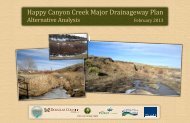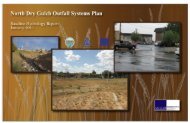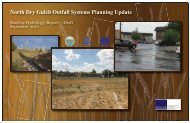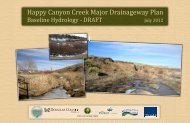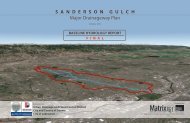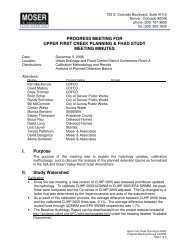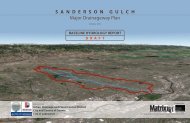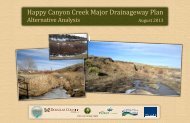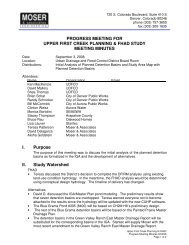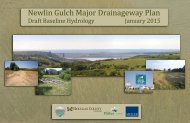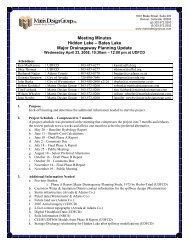Phase A - Alternatives Analysis Report - Urban Drainage and Flood ...
Phase A - Alternatives Analysis Report - Urban Drainage and Flood ...
Phase A - Alternatives Analysis Report - Urban Drainage and Flood ...
You also want an ePaper? Increase the reach of your titles
YUMPU automatically turns print PDFs into web optimized ePapers that Google loves.
PHASE A – ALTERNATIVES ANALYSIS REPORTMajor <strong>Drainage</strong>way Planning Update for Hidden Lake-Bates Lake3 HYDROLOGIC ANALYSIS3.1 OverviewA Baseline Hydrology <strong>Report</strong> was completed in June 2008 as part of this Major <strong>Drainage</strong>way PlanningUpdate for Hidden Lake <strong>and</strong> Bates Lake which updates the hydrologic analysis that was originallycompleted in 1975. Many changes have occurred in the watershed since the 1975 study, primarily related tochanges in l<strong>and</strong> use, development, <strong>and</strong> storm sewer improvements. Modifications have been made to theHidden Lake spillway since 1975. The James Baker Reservoir was constructed after the release of the 1975study. The reservoir is a raw water storage facility capable of storing the 100-year stormwater event.Peak flows were determined using the physical sub basin parameters <strong>and</strong> rainfall information, along with theexisting drainage system conveyance characteristics detailed in the Baseline Hydrology <strong>Report</strong>. The subbasin characteristics used for each sub basin on the CUHP model are shown in Table B-1 in Appendix B.The sub basins, design points, conveyance elements, detention facilities, <strong>and</strong> split flow locations used in thestudy can be seen on Figure 3-1. Table B-3 provides peak flow rate information for each of the sub basins,design points, <strong>and</strong> conveyance elements in the study area for the 2-, 5-, 10-, 25-, 50-, <strong>and</strong> 100-year stormevents with future l<strong>and</strong> use conditions.3.2 Design RainfallThe 1-hour <strong>and</strong> 6-hour rainfall depths for the 2-, 5-, 10-, 25-, 50-, <strong>and</strong> 100-year storm events were gatheredfrom Figures RA 1 through RA 12 in the <strong>Urban</strong> Storm <strong>Drainage</strong> Criteria Manual (USDCM, 2001). Therainfall depths for the corresponding design storms are shown in Table 3-1.Table 3-1Rainfall Depth (inches)Return Period 1-Hour Rainfall2-Year 0.985-Year 1.4010-Year 1.6025-Year 2.0250-Year 2.30100-Year 2.60Since the study area is less than ten square miles, no rainfall correction factor was used in this study.3.3 Subwatershed CharacteristicsA total of 30 sub basins were delineated in the Hidden Lake-Bates Lake <strong>Drainage</strong>way study area. The subbasin identification <strong>and</strong> locations are displayed on Figure 3-1. Table B-1 contains the physicalcharacteristics of each sub basin. The total area included in the study area is 4.89 square miles. Thecomposite percent impervious of the entire study area is 57.54%. Table B-2 contains thestage/storage/discharge relationships of each of the detention basins modeled.The available contour topography, storm drain network, <strong>and</strong> street network were used to modify sub basinboundaries from those shown in the 1975 study. The sub basins range in size from 29.4 acres to 165.0 acreswith a median sub basin area of 104.4 acres. The goal is to keep the sub basin area between 90 acres <strong>and</strong>130 acres. There are several reasons some of the sub-basins were delineated to have less than 90 acres.There were several key design point locations that had less than 90 acres tributary to them such as theproposed Gold Line Light Rail Station between Sheridan <strong>and</strong> Tennyson. There were some sub basins thatare tributary to specific storm drain networks that connect to the main stem system with less than 90 acrestributary to them. There are also some sub basins that are smaller than 90 acres that are directly tributary toClear Creek. Because the CUHP 2005 computer program tends to under estimate the flows for sub basinsless than 90 acres, the sub basins, that are in the interior of the study area were calibrated to be within 10%of the 100-year storm event flows. The sub basins that are directly tributary to Clear Creek do not have asignificant effect on the study area, so no calibration was completed for those sub basins.3.4 Hydrograph RoutingThe existing drainage network is generally comprised of storm drain pipe, culverts, open channels <strong>and</strong>detention basins. Figure 3-1, the Sub basin Routing Map, illustrates the location <strong>and</strong> connectivity of thedrainage system elements. The Routing Map shows where the sub basins connect into the drainage system<strong>and</strong> the specific design points defined at these locations. In addition, the routing elements illustrate wherethe runoff is connected to the next downstream design point. For clarity, the routing has also been displayedin a EPA SWMM Routing Schematic (See Figure 3-2).The routing elements within this model are open channels <strong>and</strong> conduits. The pipes within the study areawere modeled with open channels / street sections above them. Within EPA SWMM, the routing wasclassified according to the following characteristics:• Shape• Maximum Depth• Length• RoughnessFour detention basins were modeled in the hydrologic model. Two of the lakes are publicly owned <strong>and</strong> twoof them are privately owned with flowage easements. There are several other detention basins <strong>and</strong> waterquality basins within the study area, however they are privately owned <strong>and</strong> they do onto have flood controlagreements with the local agencies; therefore they were not modeled in the hydrologic model. Theattenuation in these detention basins reduce peak flows in the downstream storm drain networks. The stage/ storage / discharge relationships as well as where the routing information was obtained can be seen inTable B-2 in Appendix B. All of the routing information except the state / storage relationship for BatesLake / Homestead Park was obtained from previous studies. The storage in Bates Lake / Homestead Parkwas determined by digitizing the available 2-foot contours <strong>and</strong> applying the average-area-end method todetermine volume. For the hydrologic routing, it was assumed that Bates Lake did not have any water in itat the beginning of the storm events. For Hidden Lake, James Baker Reservoir, <strong>and</strong> Lake Sangraco it wasassumed that the lakes were full of water up to their spillway elevation at the beginning of the storm events.3-1



